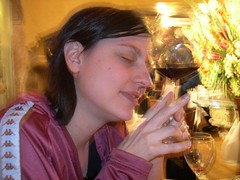James Cahill, Soter Vineyards
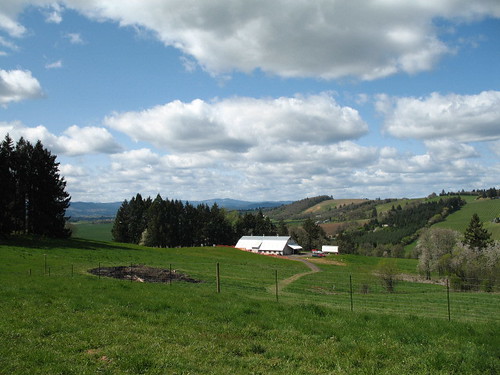
See this stellar photo? James Cahill wasn't sure if I should take it or not. "The building is a mess right now," he insisted. I guess he meant that orange construction fence in front...see it? Yeah, neither did I. I was too busy taking in the bucolic splendor of the Yamhill-Carlton district. A bit of farm equipment, an old car or two, and an orange fence aren't close to distracting.
 James is the associate winemaker for the Soter family, and Beacon Hill Vineyard is his charge. As we ascend the hill from which the above photo was taken, he tells me about every square inch of the land. We cross a large patch of soft, knee-high grass and milkweed and James builds an 8x10 in color for me of the sheep that are summoned for mowing it every so often, and how it will eventually support more Pinot Noir vines. He points to an area nearby: this is the place for a future tasting room. We stand on the edge of the hill and look down on rich farmland, and he tells me everything about the history, both ancient and recent, of this district. And that's before we've even gotten to the vineyard. This is a guy who clearly loves what he does and where he's doing it, and his enthusiasm is refreshing. It's also clear that he's got a great deal of admiration for Tony Soter, the master and commander of the family label. He speaks about Mr. Soter's vision as often as he does his own, and the two seem perfectly suited.
James is the associate winemaker for the Soter family, and Beacon Hill Vineyard is his charge. As we ascend the hill from which the above photo was taken, he tells me about every square inch of the land. We cross a large patch of soft, knee-high grass and milkweed and James builds an 8x10 in color for me of the sheep that are summoned for mowing it every so often, and how it will eventually support more Pinot Noir vines. He points to an area nearby: this is the place for a future tasting room. We stand on the edge of the hill and look down on rich farmland, and he tells me everything about the history, both ancient and recent, of this district. And that's before we've even gotten to the vineyard. This is a guy who clearly loves what he does and where he's doing it, and his enthusiasm is refreshing. It's also clear that he's got a great deal of admiration for Tony Soter, the master and commander of the family label. He speaks about Mr. Soter's vision as often as he does his own, and the two seem perfectly suited.Beacon Hill is the flagship Pinot Noir producer for Tony Soter, a beautiful 22-acre spread with blocks of vines planted as recent as 2004 and early as 1988. The original Pinot Noir vines are Pommard clones on their own rootstocks (non-geeks read: kickass French vines chosen for maximum goodness), and there are other "heirloom" clones as well. There's also a block or two of Chardonnay from '89, which goes into their sparkling wines.
The buds are just barely starting to break, and as we go along, Jim shows me what kind of detail work is done. "Human hands have to touch every vine," he says, pointing to the tiny buds at the base of the vine. These have to be shorn away so that the plant focuses on the buds above, and it's not something that can be done by a machine.
James is easy to talk to, and helps me put together a picture of sustainable farming. I'm still chewing on Allen Holstein's opinions from earlier in the day: that so-called 'organic' farming is often more of a marketing ploy than something that leads to the best possible wine. Part of my trip is to put aside anything I've learned or read about viniculture, shut up, and pay attention to what everyone says. It's really the only way to get the real picture.
James and the Soter family are dedicated to the sustainable practices on their land, and have received certification from L.I.V.E (Low Input Viniculture and Enology, Inc) for their practices. Does this mean they don't use a single wee drop of herbicide ever? No. It does mean that they do not use persistent herbicides, ones that linger for years in the soil. Sustainable farming practices are different from strict organics, but the idea is the same: make choices based on minimizing the enviornmental footprint you leave on the land, and your land will produce great fruit for decades to come.
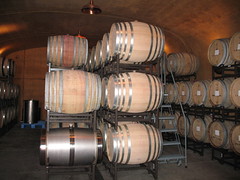 We visit the cave after our hike through the vines, a structure built into the hillside for resting bottles of bubbly and barrels of Pinot. Then it's off to taste some of the finished product. Chris Poulos, the Soter sales and marketing guy, takes over as James excuses himself to attend to some business. Chris tells me about the two vineyards, the Beacon Hill and the Soter's newest Mineral Springs Vineyard, and pours me some vino.
We visit the cave after our hike through the vines, a structure built into the hillside for resting bottles of bubbly and barrels of Pinot. Then it's off to taste some of the finished product. Chris Poulos, the Soter sales and marketing guy, takes over as James excuses himself to attend to some business. Chris tells me about the two vineyards, the Beacon Hill and the Soter's newest Mineral Springs Vineyard, and pours me some vino.I tasted five wines, all of which lived up to the stories, methods and care about which I'd been told. The 1999 Brut Rose was billed by Chris as the "best sparkler in America". I don't know about that, but it was fantastic. It's big and intense with fruit, creaminess, spice and superfine pearlage. Damn fine stuff. Grab it if you see it.
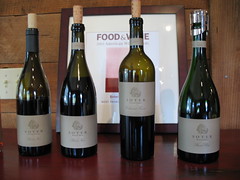
The Pinots were silky and busting at the seams with aroma, spice and personality. And none of the wines, to my delight, were way up high in alcohol. Even the ultra hot (and therefore, ultra ripe) 2003 vintage came in just a hair's-breadth over 14%. These are Pinots made by someone who loves the elegance of Pinot, and it shows. My fave was the 2004 North Valley Pinot Noir: killer structure, silkalicious, and only poised to improve with age.
The 2002 'Little Creek' Blend, mostly Cab Franc did not suck either. Juicy and earthy at the same time, big without shouting, great balance.
James Cahill spent several years living in Austin, and when he returned, we chatted about all the people we knew and where'd we go eat right then if we were there. It was good to talk to someone who knew Austin; homesickness is creeping up on me gradually and making visions of picadillo tacos and migas and margaritas dance about in my head. As I bade James goodbye, I wondered if I could leave that all behind to live in the lush green landscape of Willamette.
Tempting. But nah.
Next up: Harry Peterson-Nedry of Chehalem uses a chunk of his rare time to chat with me at a coffee house. Such a nice guy. Stay tuned.

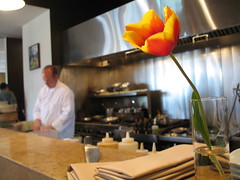 When I realized I wasn't going to get a chance to meet Luisa or Dick Ponzi, I was disappointed, but thought I'd at least swing by the
When I realized I wasn't going to get a chance to meet Luisa or Dick Ponzi, I was disappointed, but thought I'd at least swing by the 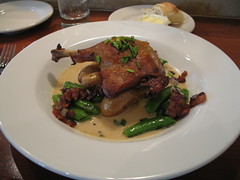 If I just had to bitch (which I do), it would be that the duck itself was pretty salty and that the leek sauce was kinda thin and broken, both of which are boo-boos that I find all the time. These are not the most heinous of oversights, but enough to make an otherwise special dish mediocre. It was not enough to dismiss them entirely, however, and there were several other dishes on the lunch menu that I hope to try sometime when I'm back that way again.
If I just had to bitch (which I do), it would be that the duck itself was pretty salty and that the leek sauce was kinda thin and broken, both of which are boo-boos that I find all the time. These are not the most heinous of oversights, but enough to make an otherwise special dish mediocre. It was not enough to dismiss them entirely, however, and there were several other dishes on the lunch menu that I hope to try sometime when I'm back that way again.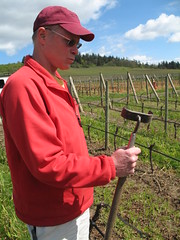 From just about anywhere in the Dundee Hills of the Willamette Valley, you can see a vineyard that depends on Allen Holstein's care. The wineries that source from them include some pretty big names in Willamette---Stoller, Domaine Drouhin, Argyle. Most of the 450 some-odd acres he maintains are Pinot Noir and various clones of Chardonnay, both of which adore the cool climate and sun. Even Allen's house atop a hill is surrounded by his own personal vineyard, one from which he once made his own label. He seemed skeptical about whether he'll ever make his own label again. He's more comfortable with his hands in the dirt than with gladhanding marketers and buyers.
From just about anywhere in the Dundee Hills of the Willamette Valley, you can see a vineyard that depends on Allen Holstein's care. The wineries that source from them include some pretty big names in Willamette---Stoller, Domaine Drouhin, Argyle. Most of the 450 some-odd acres he maintains are Pinot Noir and various clones of Chardonnay, both of which adore the cool climate and sun. Even Allen's house atop a hill is surrounded by his own personal vineyard, one from which he once made his own label. He seemed skeptical about whether he'll ever make his own label again. He's more comfortable with his hands in the dirt than with gladhanding marketers and buyers.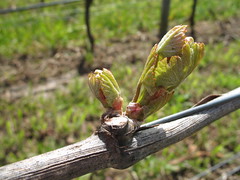 In an affected plant, the buds closest to the trunk of the vine suddenly looked burnt and withered, while the buds farther away seem fine. He's had experts from all over the world offer their theories, none of which have panned out. His own theory is controversial, and while he admits it has holes in it, reflects meticulous research, curiosity and expertise. Although I don't know squat about the inner workings of a vine's system, I find myself able to picture clearly why he's arrived at his conclusions. It occurs to me that he's probably the guy whose discoveries will make a big difference in the practices of viniculture in the Willamette. Just a hunch.
In an affected plant, the buds closest to the trunk of the vine suddenly looked burnt and withered, while the buds farther away seem fine. He's had experts from all over the world offer their theories, none of which have panned out. His own theory is controversial, and while he admits it has holes in it, reflects meticulous research, curiosity and expertise. Although I don't know squat about the inner workings of a vine's system, I find myself able to picture clearly why he's arrived at his conclusions. It occurs to me that he's probably the guy whose discoveries will make a big difference in the practices of viniculture in the Willamette. Just a hunch.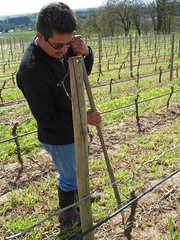
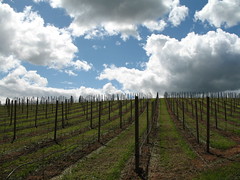
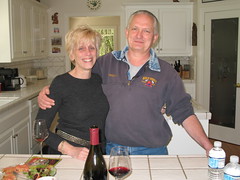 After a
After a 
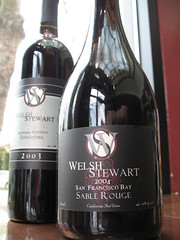 One of the things I dig on this trip is having people contact me and invite me to talk to them. Although having them within twenty miles of my epicenter is nice. Jeremy Bivins was out near Davis, roughly an hour's drive east from where I was, and I realized it would be a trek. But what the hell, I thought: I can go walk around the UC Davis Campus and make faces at the law students.
One of the things I dig on this trip is having people contact me and invite me to talk to them. Although having them within twenty miles of my epicenter is nice. Jeremy Bivins was out near Davis, roughly an hour's drive east from where I was, and I realized it would be a trek. But what the hell, I thought: I can go walk around the UC Davis Campus and make faces at the law students.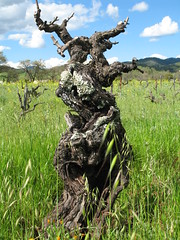 As Will Bucklin, Tom Wark and I slogged through the thigh-high mustard, rye grass and legumes, Tom teased Will: "He's given every one of these vines a name." I asked Will if that was true and he said no, not all of them. I told him I was going to call this one Miss Bertha, and he said, "She?"
As Will Bucklin, Tom Wark and I slogged through the thigh-high mustard, rye grass and legumes, Tom teased Will: "He's given every one of these vines a name." I asked Will if that was true and he said no, not all of them. I told him I was going to call this one Miss Bertha, and he said, "She?"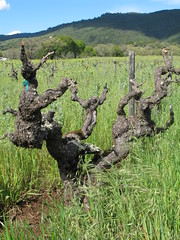 This is the oldest vineyard in Sonoma, founded 155 years ago by William McPherson Hill, the first guy to plant something other than the Mission grapes favored by the Spanish Missionaries. It's a field blend vineyard, meaning there are several different varieties growing together, seemingly willy nilly. Will Bucklin undertook the task of creating a
This is the oldest vineyard in Sonoma, founded 155 years ago by William McPherson Hill, the first guy to plant something other than the Mission grapes favored by the Spanish Missionaries. It's a field blend vineyard, meaning there are several different varieties growing together, seemingly willy nilly. Will Bucklin undertook the task of creating a 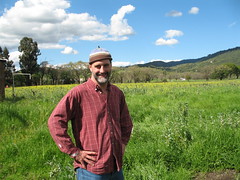
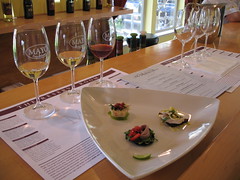 In the Sonoma Valley, you can't swing a dead cat without hitting a Mayo Family Winery tasting room. There are four total, and I passed two on my way to their latest venture: the Mayo Reserve Room. Open for about a year now, the room sports an in-house chef who serves tasty little bites that pair with seven wines, a nicely put together atmosphere, and as you can see, fancy pointy dishware.
In the Sonoma Valley, you can't swing a dead cat without hitting a Mayo Family Winery tasting room. There are four total, and I passed two on my way to their latest venture: the Mayo Reserve Room. Open for about a year now, the room sports an in-house chef who serves tasty little bites that pair with seven wines, a nicely put together atmosphere, and as you can see, fancy pointy dishware.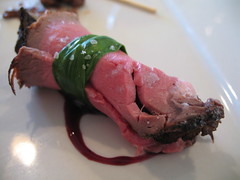 I understand the idea behind it, which is to help folks who might be trying to train their noses and palates to catch all the hints of white roses and candied apricots and supple leather or whatever, but ultimately, this pre-explanation isn't really working toward that goal. If you've been in the wine biz, you know well that if before you smell a wine, I tell you it smells
I understand the idea behind it, which is to help folks who might be trying to train their noses and palates to catch all the hints of white roses and candied apricots and supple leather or whatever, but ultimately, this pre-explanation isn't really working toward that goal. If you've been in the wine biz, you know well that if before you smell a wine, I tell you it smells 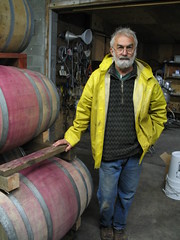 Allen Price and I arrived at the front of the little yellow tasting room at Casa Nuestra winery at the same time, both in rain gear, and both probably equally annoyed at the persistence of this unseasonable downpour. "This stuff is supposed to be over British Columbia this time of year," he says as we quicken our pace toward the cellar. "It's a fluke. Some think it's global warming, but that's only part of it. I've seen it happen before."
Allen Price and I arrived at the front of the little yellow tasting room at Casa Nuestra winery at the same time, both in rain gear, and both probably equally annoyed at the persistence of this unseasonable downpour. "This stuff is supposed to be over British Columbia this time of year," he says as we quicken our pace toward the cellar. "It's a fluke. Some think it's global warming, but that's only part of it. I've seen it happen before."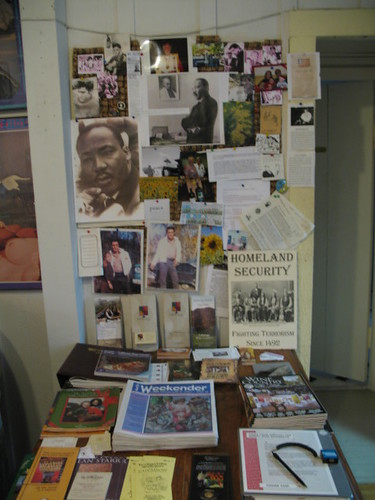
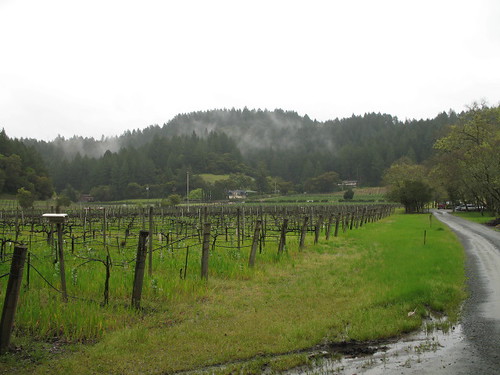
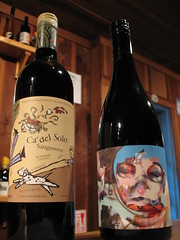
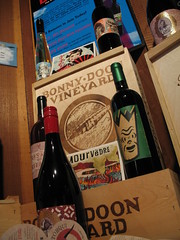 My fave was the
My fave was the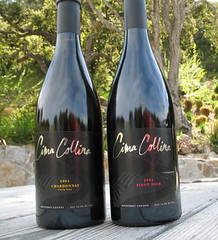
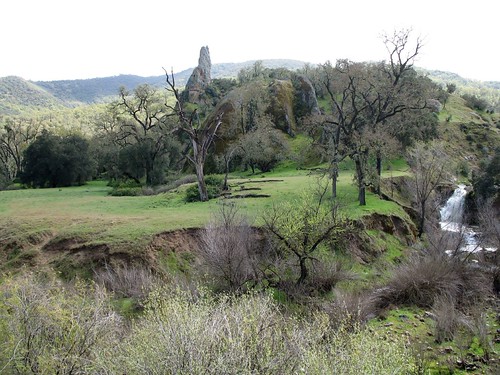 Okay, to be fair, I spent my time in the
Okay, to be fair, I spent my time in the 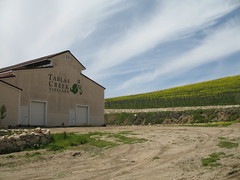 Maybe, I dunno, it depends on your value system. Pros: they are well made, ageworthy, and beautifully structured in the traditional French style. Cons: I suppose you could get a lot more for your money if you bought an actual French Rhone. Maybe. Whatever. They're damn good. Decide for yourself.
Maybe, I dunno, it depends on your value system. Pros: they are well made, ageworthy, and beautifully structured in the traditional French style. Cons: I suppose you could get a lot more for your money if you bought an actual French Rhone. Maybe. Whatever. They're damn good. Decide for yourself.
